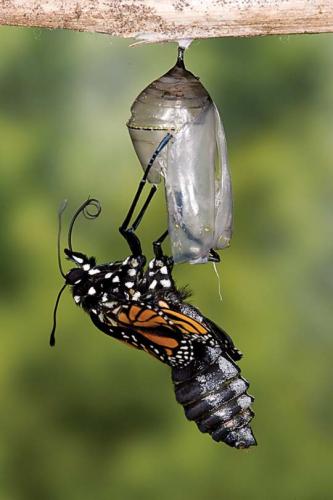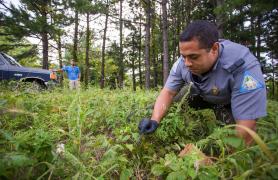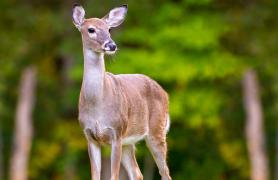Sept. 20, 2007 Columbia, Missouri 39 N Latitude
This is the moment when I first hear a butterfly’s wings: We are standing in a goldenrod meadow, my 4-year-old daughter and I, but it feels as though we’re inside a snow globe. A blizzard of orange-and-black butterflies swirls around us — hundreds of monarchs, the most I’ve ever seen in one place. But Maya pays no attention. Her eyes are locked on the creature folded origami-like between her thumb and forefinger. She turns her hand this way and that, examining the quivering antennae, the bristly legs, the delicate proboscis curled into a spiral.
Then, after glancing up to make sure I won’t miss the magic that’s about to unfold, she extends her pudgy arm, and opens her fingers. As the butterfly flutters skyward, a tinkling giggle escapes Maya’s mouth. And from that moment forth, whenever I see a monarch flittering in the breeze, my daughter’s laughter is the sound that I hear.
A few days earlier, several dozen tiny round stickers had arrived in our mailbox. They were butterfly tags from Monarch Watch, a conservation, education, and research nonprofit based out of the University of Kansas. We were to affix a sticker to the hind wing of any monarch we caught. If one of our butterflies wound up in the hands of someone else, a code printed on the sticker would match the monarch to where we had tagged it.
The butterfly Maya had just released was wearing such a sticker. JNE152 was a large, newly emerged female. We don’t know where she went immediately after leaving Maya’s hand. But we do know where, three months later, she ended up: Mexico.
Migration Mystery
Danaus plexippus is North America’s most far-flung butterfly. Every fall, monarchs east of the Rockies migrate up to 3,000 miles south to reach their wintering grounds in the mountains of central Mexico. In Missouri, migration reaches full flutter in mid-September, when cool weather, dying milkweed, and changing day lengths trigger the itch to wander.
Why do monarchs migrate? If you were to chart their family tree, you’d find it’s made entirely of tropical and subtropical ancestors. None of the family members — including monarchs themselves — are equipped to survive temperate-zone winters. But milkweeds, the plants most essential to a monarch’s life cycle, grow all the way into Canada. To take advantage of this resource, monarchs evolved the ability to follow sprouting milkweeds north in the spring and then hightail it south in the fall.
JNE152 was born in late August. This made her different in several important ways from monarchs born in spring and summer. For one thing, she had emerged from her chrysalis in a state known as reproductive diapause. This simply meant that her urge to mate was temporarily turned off. For another, if her luck held, JNE152 might live up to nine months.
A summer monarch would do well to persist past five weeks. And finally, a change in one of JNE152’s genes made her flight muscles more efficient. Essentially, summer monarchs were sprinters. Fall monarchs were marathoners.
Exodus
OCT. 3, 2007 Okmulgee, Oklahoma 35 N Latitude
JNE152 had sailed out of Missouri and was now fluttering through the Sooner State. On average, she moved about 30 miles daily, but with clear skies and a strong tailwind, she was capable of cruising at 15 mph and putting more than 100 miles behind her. Like most migrating monarchs, she spent about 10 hours aloft each day, touching down periodically to refuel on nectar.
A monarch’s glide ratio is such that every 4 feet of forward progress is accompanied by a drop of 1 foot in altitude. To conserve energy, monarchs ride updrafts, and pilots routinely spot them flying above 10,000 feet. On peak migration days, it’s likely thousands of monarchs glide by overhead without notice.
Storms often blow migrants hundreds of miles off course. Droughts wilt nectar sources. Highways present a gauntlet for low-flyers. And the threat of frost is ever present. Though scads of animals eat monarchs, predation is mitigated by the diet of the larvae.
Milkweed, the only plant a monarch caterpillar will eat, brews in its cells a chemical concoction of toxins known as cardenolides. Nibble a little milkweed, and you’ll vomit violently. Eat a bunch of milkweed, and your heart will stop.
Monarch larvae store cardenolides in their body tissues. The toxins remain after metamorphosis, making adult monarchs poisonous even though they no longer feed on milkweed leaves. The striking orange-and-black pattern on a monarch’s wings is a warning: This bite sized butterfly is deadly to eat.
South by Southwest
Oct. 24, 2007 Asherton, Texas 28 N Latitude
In the Hill Country of southwest Texas, JNE152 slowed her pace and devoted more time to sipping nectar. Migrating monarchs actually get fatter as they fly south. Nectar becomes scarce during winter, so migrants must ration their fat to survive until spring.
To find her way, JNE152 used a sun compass in her brain and a clock in her antennae. If her clock read 8 a.m., she flew to the west of the sun. At noon, she flew straight toward the sun.
And at 5 p.m., she kept the sun off her starboard wing. In this way, migrating monarchs are able to maintain a more-or-less south by southwest bearing.
Landscape features also offer navigational clues. The Gulf of Mexico turns migrants west toward southern Texas. From there, two mountain ranges — the Sierra Madre Orientals and the Sierra Madre Occidentals — funnel migrants down the spine of Mexico to a relatively small region northwest of Mexico City.
Nov. 1, 2007
El Rosario, Mexico 19.5 N Latitude
If she kept pace with her fellow migrants, JNE152 probably fluttered through the sleepy village of El Rosario during Day of the Dead, a time when Mexicans honor their dearly departed. The monarchs’ arrival is so punctual that people of the region associate the cascades of orange-and-black butterflies with souls of their loved ones returning from the afterlife.
By mid-November, JNE152 sought sanctuary in the oyamel fir forests in the mountains above El Rosario. There, at an elevation of about 11,000 feet, monarchs huddle together on trees in clusters so dense that they sometimes break branches. Most clusters form 20 to 50 feet above the ground. This is the Goldilocks zone, where temperatures stay cold enough to slow a monarch’s metabolism but not so cold that a monarch freezes to death.
Although locals had known about the overwintering colonies for centuries, their exact location had remained a secret to science until late in the 20th century. Dr. Fred Urquhart of the University of Toronto began tagging monarchs in the 1930s. Decades of data led him to believe that the monarch stronghold must be somewhere west of Mexico City. He hired Ken Brugger, an engineer working in Mexico, to search for the sites. Locals led Ken to the colonies in January 1975. It was the entomological equivalent of discovering E=MC2.
Relay for Life
March 15, 2008 Tulsa, Oklahoma 36 N Latitude
By the end of February, JNE152 was once again on the move. As she left the mountains
of Mexico and forged northward, she laid eggs, scattering more than 400 across nearly a thousand miles of milkweed.
Eventually, her pale wings grew bushripped and bird-torn. And on a warm day in March, she touched down for the last time somewhere south of Tulsa. Though a handful of monarchs may return home, most scatter their scales far short of their birthplaces. But tucked under milkweed leaves from San Antonio to St. Augustine are billions of crystalline eggs.
Out of these hatch comma-sized caterpillars. Each gorges on milkweed, splitting its skin five times in the process. After its fifth molt, the caterpillar suspends itself under a sturdy leaf and curls into a “J.” When its skin splits a final time, a jade green chrysalis is revealed.
The adults that emerge,10 to 14 days later, flutter northward. They mate and lay eggs as they go, until North America once again brims with butterflies.
Despair
AUG. 1, 2017 Columbia, Missouri 39 N Latitude
In the decade since JNE152’s journey, my daughter has grown bigger, and monarch numbers have grown smaller. Eastern populations are measured by the area they occupy at overwintering sites in Mexico. In 1996, overwintering butterflies covered nearly 21 hectares. In 2014, they covered less than one. Biologists estimate that monarch numbers have shrunk by nearly a billion butterflies since 1990. The population is now so small that a single disaster in Mexico — a winter storm, for example — could wipe it out.
What has caused the declines? Illegal logging of overwintering habitat is partially to blame. Climate change, and the unpredictable weather it may spawn, also concerns scientists. But the biggest threat is the disappearance of milkweed due to land development and the widespread use of herbicides.
Monarch Watch calculates that nearly 2.2 million acres of milkweed vanishes from the U.S. each year. By conservative estimates, roughly 200,000 square miles of habitat has been lost since 1996. Unless things change, the outlook for migrating monarchs looks grim.
Hope
Letting go of a tagged monarch is an exercise in hope. You hope, despite the odds, that the plucky little creature will survive its perilous journey. You hope its offspring will return the following spring. You hope your daughter will have the chance to watch her own child release a monarch someday. You hope that she, too, might hear the sound of a butterfly’s wings.
In the 1960s, a meteorologist working at MIT discovered something profound about how nature works. He was running a computer program that simulated weather patterns, and he had just made a tiny, seemingly inconsequential change to one of the variables. When he ran the program again, what was once drizzle in New England had morphed into a tornado over the Midwest. The pattern became known as the “butterfly effect” because it suggested that the flapping of a butterfly’s wings could change the course of a hurricane.
In other words, tiny changes can lead to big consequences.
Can the same idea apply to monarchs? Can small actions change their fate?
That’s what thousands of monarch enthusiasts are banking on. Across the U.S., Canada, and Mexico, volunteers are planting milkweed, helping scientists track monarchs, and educating others about this iconic insect. I hope you’ll join the effort.
Follow the Flutter
- Monarchs spend winter in central Mexico. In March, they flutter north.
- Females lay eggs across the south, then they die.
- Their offspring live two to six weeks. Each generation spreads farther north.
- Monarchs born in August and September return to the same mountains in Mexico that their great-great-grandparents used the previous fall!
Temperature plays a role in how long it takes for an egg to become an adult. Although it typically takes 30–35 days, it can be as short as 25 days or as long as 50 days.
On average, a female monarch lays about 400 eggs. Only a few survive to adulthood.
- Larva The first thing a larva eats is the eggshell it hatched from. After that, it subsists on a strict diet of milkweed.
- Rapid Growth Larvae grow at an incredible clip. In only 15 days, a larva may be 3,000 times heavier than its weight at hatching.
- Shedding When a caterpillar has grown too large for its own skin, the skin splits and sloughs off.
Save the Monarchs
Rescuing one of nature’s most miraculous migrations will require more than hope.
Fortunately, people across the country — from school kids, to homeowners, to farmers — are pitching in to save this iconic insect. If you want to get involved, here are a few helpful resources.
- The Monarch Joint Venture acts as a clearinghouse for nationwide monarch conservation efforts and information. Visit them at monarchjointventure.org.
- The U.S. Fish and Wildlife Service offers monarch conservation tips for homeowners, landowners, and communities at fws.gov/savethemonarch.
- If you want to tag monarchs, Monarch Watch is the place to go. Their website also provides top-notch information on monarch biology, migration, and conservation. Check it out at monarchwatch.org.
- To report monarch sightings and follow spring and fall migrations, visit Journey North at learner.org/jnorth/monarch.
- For landscape plans and a list of recommended plants to create backyard monarch habitat, visit mdc.mo.gov/monarch.
- Local sources for monarch friendly plants can be found at grownative.org.
- Missourians for Monarchs seeks to connect Show-Me State residents who are working to create and protect monarch habitat. Check them out at facebook.com/MissouriansForMonarchs.


























Also In This Issue


And More...
This Issue's Staff
Associate Editor - Bonnie Chasteen
Staff Writer - Larry Archer
Staff Writer - Heather Feeler
Staff Writer - Kristie Hilgedick
Staff Writer - Joe Jerek
Creative Director - Stephanie Thurber
Art Director - Cliff White
Designer - Les Fortenberry
Designer - Marci Porter
Photographer - Noppadol Paothong
Photographer - David Stonner
Circulation - Laura Scheuler






















